Brand Development, Web Design, and Google Analytics Specialists
Experienced in SEM, SEO, Social Media, and Traditional Media
How to Define Goals for Your Social Media Strategy

How to Define Goals for Your Social Media Strategy
Are you struggling with your company’s social media accounts? Do you keep posting, but not gaining any followers?
If so, you’re not alone. In fact, many business owners don’t know the first thing about social media marketing and influencer marketing. This should come as no surprise since most business owners are experts in their own fields, not in social media branding.
If you’re new to online marketing, you may not even know where to begin. Facebook? Twitter? Instagram? Google analytics? What are the best social media platforms for your brand to achieve your business goals? And how do you reach your target audience?
We’ve put together a brief guide on how to build your social media brand. Here are some of the most important decisions you’ll need to make, and how to measure your success.
Decide why you’re on social media
To begin with, you’ll need to decide why your business is pushing for a social media marketing strategy in the first place. Likes and retweets can be fun, and give you a warm fuzzy feeling, but they’re not going to make you any money.
There are many ways to earn money on social media. You can use your accounts to drive traffic to your website or to increase brand awareness. You can even use it to announce new products to your existing customers and even make money through your click-through rate.
Social media can also be useful for less obvious reasons. You can use social media to provide customer support or just to listen to what people are saying about your brand and achieve your goal-setting strategies. For example, if you run a burger shop called Jim’s Burgers, you can keep an eye out for #JimsBurgers on Twitter. This is a great way to hear exactly what people are saying about you.
Decide on your target audience
Before you post anything on different media platforms, ask yourself who your potential customers are. Before you make any other decisions, you’ll need to have this figured out otherwise your social media efforts will never reach achieve your objectives. What you share, when you share it and what platform you use for brand awareness is going to depend on who you’re trying to reach.
For example, let’s say you manufacture custom bicycle helmets. Who is your target audience in media marketing?
It’s not going to be a single mom who’s buying a helmet for her six-year-old. She’s going to buy the Wal Mart special. Here, a campaign hitting all social media channels would be wasted. Your target audience is avid cyclists, people who ride every day and are willing to spend extra money for a helmet they like.
Decide what you’re going to share
Now that you know your target audience, you’re ready to start posting. For the rest of this article, we’ll continue with our bicycle helmet example, just so we’re consistent.
One trap that many companies fall into is only posting ads. This is great if you already have a large, established audience. It’s also a good way to drive brand awareness or reach out to the press, but it’s not going to grow your customer base.
For cyclists, why not post articles about the Tour de France or other major cycling events? People aren’t going to share ads, but they’ll share fun articles about things they care about. Their friends, in turn, may follow your page to see more of what you’re sharing. Of course, this will also include some ads.
Decide when you’re going to share it
When you share something is almost as important as what you’re sharing. Simply put, if your audience isn’t online when you’re sharing, you’re doing the online equivalent of screaming into the void.
Our cycling company, for example, will want to keep an eye on cycling events on ESPN2, as well as major events like the Olympics and the Tour de France. Like most sports fans, cyclists are liable to get online before and after these events to share their thoughts.
If you post a cycling article just as the Tour de France ends, it’s liable to be on top of your customers’ feed when they log in.
The end result? You’ve basically placed a targeted ad, without paying a dime for it.
Learn from your competitors
In the olden days, it was extremely difficult to determine whether your competitors’ marketing strategies were working for them. Even if they ran a successful campaign, it could take a team of experts to slice and dice focus group data to determine just why they succeeded.
Now, you can do all this for free, just by following your competitors on social media. Watch which of their posts get the most traction and copy any strategies that work.
Conversely, you can also see where they fall flat. If they suddenly get a flurry of angry tweets directed at them, find out why. Then (obviously) don’t do whatever they did.
Focus on metrics that matter
Like we said before, likes and retweets make you feel good, but they don’t pay the bills. Instead of focusing on these meaningless metrics, treat social media like any other kind of advertising.
Specifically, tie your metrics to the reason you’re on social media to begin with. If you’re trying to drive traffic to your website, for example, see if you had any spikes in traffic after posting. If you did, your strategy is working. If you didn’t, then it doesn’t matter how many people clicked the thumbs-up button.
By keeping your eye on the ball and not getting distracted by social media bells and whistles, you’ll be setting your business up for success.
Get a professional team
Of course, you probably have more important things to do with your time. And hiring someone to run your social media campaign in-house can be challenging if you don’t know what to ask them during the interview.
If you want to launch a social media campaign, but running one isn’t in your wheelhouse, consider hiring a professional marketing firm. These companies specialize in social media campaigns to build your online brand. They’ll manage your social media, optimize your site for search engines and much more.
If all of this sounds too daunting, there are businesses that specialize in social media marketing optimization like our agency Above The Fold. If you’re interested in what our team has to offer, contact us today to receive a free consultation.
10 Social Media Marketing Tips For San Diego Businesses In 2019

As a shiny new year dawns, everything feels new and bright. What were marketing challenges for the small business last year are now marketing opportunities. Social media will continue to play a vital role in attracting customers to a business and with a more geographical slant, so a small business in San Diego needs to be confident they are harnessing every opportunity that comes their way with regards to San Diego social media marketing.
#1 Don’t underplay organic reach
When phrases like ‘organic reach’ are used, it is referring to the natural growth and engagement of a brand with its customers via its chosen social media platforms. There is marketing to sell and then there is more subtle marketing that suggests and builds connections over time.
In short, forget being a slave to social media algorithms and make 2019 the year you reach out to people.
#2 Go local
Social media is a BIG place, as is the web but increasingly, we are seeing businesses using their geographical location to physically connect them to customers. As a small business, if your customers are San Diego bound, then steer your posts, captions and stories to include your location.
#3 Go Live!
You may have seen that live streaming is attracting attention and there are many ways that a business can harness this opportunity. From live streaming the lunchtime rush to a live stream of today’s great offers and so on, you attract a lot of attention to your business via social media.
Most social media platforms support and encourage video – you just need to look at IGTV success for encouragement – and they don’t have to be scripted or directed either. Neither do they need to be of epic proportions.
Consider what you could video and live stream in San Diego in 2019. Would this add to the customer experience?
#4 Talk WITH people, not AT them
There is a difference between letting people know who you are, what you do and how to use your products or get the best from your services without lecturing them or talking at them.
It is a subtle tweak not just to the copy but to the overall brand voice too. For example, ‘buy your doughnuts from us because they are the best’ comes across better than ‘buy your doughnuts from us because yours will never be as good’. Feel the burn…
#5 Numbers won’t be everything
Halfway through the list and we come to the sticky questions of metrics, key performance indicators and return on investment for social media marketing in San Diego. On one hand, it is useful and important to see who you are reaching and when, as well as how much and fast your pages are growing.
But on the other, these figures mean very little because numbers are not the only means of measuring popularity. There is also the age-old argument of quality over quantity. It is best to have 100 genuine followers than a 1,000 bots.
If there is one trend for San Diego social media marketing you adopt this year, it is to connect with real people and forget the numbers game, just a little bit at least.
#6 Put the social back into social media
Social media, arguably, was started to connect people, build relationships and friendships and so on. negativity creeps in, however, and we have trolls plaguing people and businesses with negative comments and unpleasantness.
There is a swing to claiming back the social aspect of social media, with positivity something that many brands are utilizing to their benefit. As a small business, you can do the same.
Be approachable and engaging with your content. Take a look at how your competitors interact but also take a look at how big brands get it right – and wrong!
#7 Add value to the content
Social media marketing is not just about selling.
There are posts that you will obviously target your customers, enticing them to spend their money with you. From money off for a limited period of time to other deals, there are some posts that will obviously be marketing.
But these don’t need to be the only posts you send out or even the majority of the content you create and send. Following on from putting the social back into your posts, add value to your post too.
For example, don’t just sell trips, post about how to stay safe when traveling or tips on how to pack a suitcase for crease-free clothes. Consider what it is your customers an followers want to hear about.
#8 Be agile
We assume that as a small business, there is little opportunity or openings to compete with the ‘big brands’ but actually, social media marketing can level the playing field if you know how to create a winning social media marketing strategy.
You need a strategy, a plan, and great content along with consistency of posting and plenty of engagement.
#9 Great results can be achieved on a budget
You don’t have to throw thousands of dollars you don’t have at social media marketing. Working smarter not harder or with a high price tag is the key to unlocking the potential of social media marketing for your business.
You just might need help to do it…
#10 Content needs to be of the highest quality
Social media is bustling and busy. All that noise means getting heard can be more difficult than we would like it to be. With this in mind, you need to be confident that you are posting the right kind of content that supports and develops your business, but that customers all find attractive.
Whilst we said at the start that organic reach needs to have a heavier emphasis on it, if the content you are posting is not hitting the triggers of your customers as well as social media algorithms, your posts will be lost in the noise.
It feels and looks complicated. It can feel overwhelming too, coming up with a solid social media marketing strategy for 2019. We understand this, which is why we offer a free consultation on the where, why and how of social media, as well as how best to apply these to your San Diego business. Contact Above The Fold Agency today by clicking here for a free consultation.
10 Reputation Management Tips for Small Businesses

Ideally, when customers search for your San Diego business online, they should come across your website and social media channels. Positive reviews and mentions are also welcome.
Your brand’s reputation is important, and for small businesses, building this online can make a big difference as to whether people trust you enough to buy from you.
Not all businesses pay full attention to their online reputation. For emerging small San Diego businesses, with so much else to do, keeping an eye on what is being said about you online can fall down the list of priorities. How can you manage your reputation online to build a positive and attractive one?
#1 Optimize your website
From making sure your company name is used in the content of your website to optimizing pages in the ‘background’ with meta tags and descriptions, the more you do to make your website ‘findable’ by search engines, the better.
Use a mix of the first person such as “we bake cakes” as well as your company name, “at Cake Empire, we bake cakes”.
#2 Build on your web presence all of the time
Whilst you cannot control everything about your brand online, being proactive in getting your website onto page 1 of the rankings is time better spent than chasing negative reviews.
Keywords are part of SEO but rather than seeing it as a paper exercise, establishing your small business in San Diego or wherever you’re based as an emerging authority of key areas is critical to diversifying your web presence.
For example, if you’re a small business baking cakes, your blog, for example, might include topics on types of icing, what kind of cake flavors are popular, traditions associated with wedding cakes and so on.
#3 Harness social media
Social media is incredibly powerful when it comes to marketing and small business reputation in San Diego and across the globe. It can also be powerful when people have complaints when they have been treated poorly by a brand and so on.
Essentially, just like your website, you need to capture, control and direct social media around your business. When you have decided which platforms are best for bridging the gap between you and your customers, make sure you maintain a vibrant approach with consistent posts of high quality and value. And stick with it.
#4 Collaborate
For too long, we saw the business world as cut-throat. A business stood alone in a sea of nasty competitors.
As a small business, you do have competitors and clearly, partnering with them is not the right move. But working with a collaborator is.
What other business or social media influencers could you link with that gives mutual benefits online? A cake baker, for example, might want to collaborate with a local party venue or a newly established delivery company might want to partner with a packaging firm, and so on.
By connecting and collaborating online, you are creating a stronger impression and reputation.
#5 Monitor what is being said
From setting up Google Alerts for certain keywords to googling your small business name every month, keep an eye o what is being said online. As well as positive comments, keep an eye out for those negative ones and if necessary or appropriate, you may want to deal with them.
#6 To respond or not? Negative comments…
Negative comments can be hurtful, damning and for some brands, a PR disaster. The first rule of responding to negative comments is to respond within proportion. For example, if ONE customer said they had a rubbish experience, apologise and offer to put it right.
If you are receiving a steady string of negative comments or feedback, there may be bigger issues at stake. As well as telling your side of the story to give some balance to the whole thing, you should also act on the signals your customers are giving you. For example, are their customer service gripes justified? What can you change?
#7 Offline reputation is also important (and linked to your online reputation)
If customers receive shabby service in person from your brand, then you may find that ends up online too, as most things do these days. By making sure all customers, online and offline, get a great service and product, you look after your small business reputation as a whole.
#8 Send out press releases
Press releases are all about PR and by sending them out to new San Diego outlets and popular websites, bloggers and influencers for a mention, you are supporting your growing online reputation. Optimize the press release, making sure your company name is mentioned and you use keywords associated with the content of your website.
#9 Keep an eye on Wikipedia
Whether you hold weight with Wikipedia or not, it seems that Google does. You may have noticed yourself that when searching for products or information, Wikipedia results are common on page 1.
Therefore, consider starting and editing your own Wikipedia brand page. However, anyone can edit and this may mean that erroneous information is put out there as well as commenting on negativities within the guidelines of the Wikipedia community.
#10 It takes times
Negative comments and other issues online can take a long, long time to resolve. It seems the internet never forgets. Even you have moved on, just when you least need it, the string of negative reviews pops up. Again.
There is no quick fix, even with an online management company working with you. Prevention of negative comments etc. online is key to reputation management. Most businesses, especially new ones, will take great strides in doing the best they can for their customers.
But there are occasions when things go wrong. Someone is left with a gripe and they take to social media to let the world now. How you respond is important. It needs to be proportionate and an attempt to resolve the situation.
When it looks likes there is a bigger issue, as a business, you need to listen and put it right. If you do reach this point, you may find that to banish the negativity online, you will need a consistent effort to counter it with positive stuff. But it can be done.
Databox: How to Track Your Social Results

As a marketer, analytics and data is a huge part of my life. I am constantly searching for consistencies and patterns, and adjusting along the way when things aren’t trending in directions I would like for my clients. Making these changes requires a lot of data research, and I have been using this website Databox.com to gather the numbers, and organize reports so that I can easily see social media metrics and progress daily.
How does Databox work?
Databox pulls all your data into one place, so you can track performance and insights on your business, marketing, and/or sales all in one place in real-time. Once you create an account on Databox.com, Databox then brings you to a page that includes over 65 different integrations including Google Analytics, Hub Spot, LinkedIn, Facebook, and Twitter. Those are just a few of the most popular. Linking your accounts is easy. You simply click which account you’d like to link, and then login to that account and approve the connection. Once you link the social accounts that you want to measure to Databox, they show up on your home screen as soon as you login. You also always have the option to add on more accounts as you go.
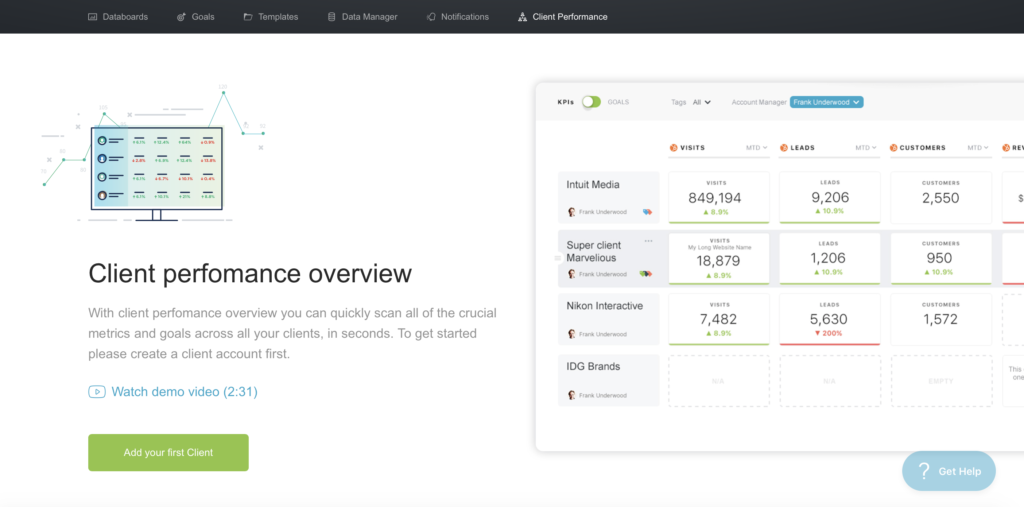
Advantages of Databox
The home page gives you 5 different tabs that allow you to take advantage of the usefulness of Databox.
• The option to set and track your goals for yourself, your business, or your team. You have the ability to set time-bound numeric goals and track your progress on these personalized goals.
• The option to change the template of your accounts to your liking.
• The option to manage account data.
• The option to view notifications (scorecards and alerts).
• And the option to add clients for overview performance so you can quickly scan your goals and metrics across all clients.
These options allow you to customize each client’s reports, and manage the data easily and quickly. If a client has a specific need or wants to see different metrics, I can easily switch things out on the home page and make new reports based on the new settings.

Databox Data Board Tab
On the data board tab, where you have access to your accounts- on the right side you are able to see your setup progress, and what you have left to do in order to become a registered partner (level one). This unlocks many benefits including being listed in the Databox partner directory, increased exposure from features in Databox, self-service email support, and the ability to vote in new features and integrations. Once you unlock level one, there are two more levels: Certified Partner, and Premier Partner. Each level gives you access to more and more benefits. Even without these benefits the site still helps you see your growth and progress without having to login to every social account separately and look at each post and like and engagement. On the data board tab, you are also able to access a ton of information on your accounts. You can customize the information that you want the ability to view.

Databox Data Points
Databox has tons of valuable information right on the home page for you to click and look at visually. Things like LinkedIn followers, Facebook page likes, and Twitter followers were some of the most popular that I chose for the first client I plugged into the software, but there are different metrics based on the various social channels you plug in. Every metric is customizable, so it depends on you to decide what is most important to you when you are looking at your goals and matching them up to the results you get with the software tracking.
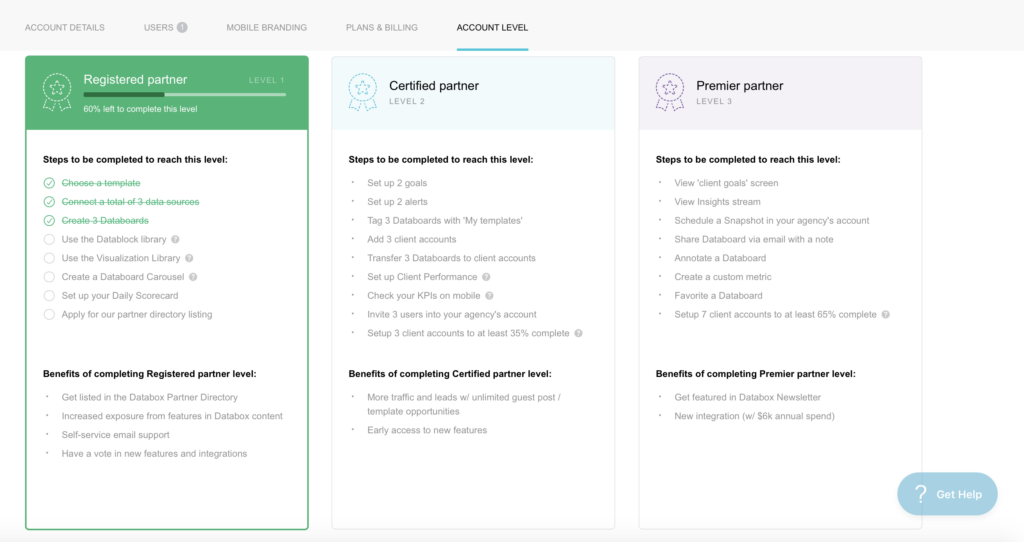
Overall
Databox is extremely helpful because it allows you to manage multiple accounts at once and provides important metrics that provides you with helpful information to grow and drive traffic to your accounts. It helps you identify what is working and what isn’t. It helps me provide my clients the information they need to make the best educated decisions for their business and brand. If you’re looking for a great software to use to gain insights into your social progress, try Databox today.
Top 10 Marketing Tactics for 2018

In our society today, we have seen a large shift into digital and social media marketing. Although many of us will look up on our way to work and see a large billboard that is semi clever, most of the products and services that attract us will be found through tv and social media. Today we are going to discuss 10 of our favorite and most popular marketing tactics to use this year.
1. Undercover Marketing
This is one of our favorite types of marketing, however it does not get enough use. Actors will be placed in a public area using the product, and people standing by will be intrigued to ask what it is. Once they do that, the actor will allow them to try it out and provide information. Undercover marketing is stealthy and noninvasive, however reels customers into buying a product. For example, when Sony Ericsson had actors pose as tourists, asking people to take a picture of them so that they could see for themselves the amazing new picture phone.
2. Social Media Influencer/Brand Ambassador
This form of marketing has been the most up and coming this year. Companies will reach out to Instagram/twitter/snapchat users with a large following and pay them or offer them a discount on their product to give them “shoutouts”. Social Media influencers will post pictures/videos of them using the product and recommend them to their followers. A lot of the time, Influencers are given a discount code to share with their followers as well which is even more attractive.
3. Product Placement
Product placement might seem obvious to some consumers; however, it is an effective marketing tactic. Product placement is when companies pay to have their products featured in certain movies or TV shows. Product placement can go from a shirt a celebrity is wearing in a movie, to the drink they have in their hand, to what brand laptop that they are typing on. A lot of times it is sneaky how the product is placed, but even if the consumer may not notice it it will still be in the back of their minds. Sometimes, product placement doesn’t even have to show the actual product, but it can be part of a conversation within the dialogue of a movie/tv show.
4. Newsletter
This is a smart tactic to keep your consumers attention. When a customer buys your product, give them the option to sign up for emails that include special offers, this way you will be able to keep your consumer updated with deals and updates, while keeping their attention on your product/service.
5. Guest Blogging
Although providing content for your product or service on your own output creates attention, it is also important to show up on other outlets as well. Doing this helps grow your consumer market by introducing your product/service to a new audience that may not have stumbled upon it otherwise.
6. Positive Reviews/References
Creating a yelp page or having a system where customers can rate your product/service after buying, makes a large difference in future success. Many people will look towards previous customer reviews before making a purchase as their deciding factor on the product/service. This also leads into buzz marketing, or word-of-mouth marketing, where customers will speak of your product to their family or friends, and this trend will continue.
7. Content Marketing
Content marketing is a smart way to indirectly sell your product/service. It provides the consumer with information and education, and shares material that relates to your brand rather than directly advertises it. This engages your target market because it allows them to make their own choice with the information available, and also builds your brands respect and credibility.
8. SEO
Search Engine Optimization is a learned task that will take time and effort. You cannot do it once and expect results. However, once you have perfected this skill specifically to your marketing efforts, it will work very effectively in your favor. The visibility of your site among others will be much more readily available, and you will learn how to better write/post content that attracts more viewers.
9. Use Social Media Analytics Tools
Our favorite tools to use are BuzzSumo and Sprout Social. These tools help you identify what of your content is doing well and what you should continue to do. It communicates with customers and measures how successful your marketing efforts are.
10. TAKE ADVANTAGE OF SOCIAL MEDIA PLATFORMS!!
There are so many social media platforms out there that are readily available to use and take advantage of. Each platform does better at certain things. For example, Instagram is best for photo content. LinkedIn, Instagram, Facebook, Twitter, Youtube, and Snapchat are all free applications that will only serve to benefit your product/service marketing efforts.
We hope that this article will be helpful and help you succeed in your marketing efforts. Let us know what you liked best or what you saw truly make a positive difference in your success!
8 Old School Marketing Tactics That Work for Social Media

Link to Original article
Okay, so it’s hard to imagine Don Draper meeting with Bethlehem Steel execs in Sterling Cooper’s top floor Madison Avenue boardroom, telling them to get on Snapchat. But even though we no longer think of typewriters as “technology” or describe TVs as “radios with pictures,” there are plenty of solid ideas from the Mad Men-era of advertising that translate to social media.
So let’s throw it back to a time before #ThrowbackThursday existed for some good old-fashioned advice from the old-school pros.
1. Doing smart, thorough research
In the premier episode of Mad Men, Don Draper trashes an in-house researcher’s report on the psychology of cigarette users and decides to wing a presentation for Lucky Strike executives instead. While Draper pulls it off, not all ad executives were so cavalier.
“Advertising people who ignore research are as dangerous as generals who ignore decodes of enemy signals,” said David Ogilvy, the founder of Ogilvy & Mather who was credited as the “Original Mad Man” and the “Father of Advertising.”
Ogilvy’s experience at Gallup’s Audience Research Institute taught him to value data way before Big Data became a thing. His knack for research-supported copywriting is best exemplified in his headline for a 1960s Rolls-Royce ad, widely considered one of the best auto taglines of all time.

Nowadays, social media marketers looking to emulate the OG Mad Man’s advice should support their strategies with analytics platforms and research-backed ideas.
2. Learning the rules, then breaking them
There are more game changers in the Advertising Hall of Fame than there are rule followers.
“Rules are what the artist breaks; the memorable never emerged from a formula,” said ad exec William Bernbach, creative director who co-founded the agency Doyle Dane Bernbach in 1949.
Bernbach’s “Think Small” campaign for Volkswagen in the 1960s threw out the rulebook for traditional print ads. To sell the compact Beetle to muscle car-crazed Americans, Bernbach’s team departed from convention by picturing a very tiny car on a page filled mainly with blank space. The small idea translated to a big boost in sales and brand loyalty.

Rule breaking may seem trickier on social media, but it’s still possible. BETC’s “Like My Addiction” campaign caught more than 100K Instagrammers by surprise with the reveal that the Parisian “it girl” Louise Delage was a fake account designed to portray a textbook alcoholic. Created for French organization Addict Aide, the initiative demonstrated that it can be difficult to spot signs of youth alcoholism.
3. Avoiding sleazy bait-and-switch tactics
Known as the world’s first female copywriter and the author of the first ad to use sex appeal, Helen Lansdowne Resor was keeping advertising real long before the ad men of the swinging 60s and 70s came onto the scene.
Her conviction that “copy must be believable,” can be found throughout her entire body of work, including her early copywriting for Woodbury Soap Company in 1910. Smooth taglines like “A skin you love to touch,” and “Your skin is what you make it” remained in circulation for decades.

Social media marketers can take Lansdowne Resor’s point in two ways. First, copy should not be too over-the-top or exaggerated, especially since teens are skeptical when it comes to trusting brands. Avoid empty platitudes or superlatives that may arouse doubt.
Second, don’t lie. Millennials are 43 percent more likely than other generations to call a brand out on social media. You dig?
4. Getting right to the heart of things
It’s hard to imagine that the “I ❤ New York” slogan was invented in a pre-emoji world. Sparse in word count and minimal in design, the logo is emblematic of co-creator Jane Maas’ direct approach to advertising.

In How to Advertise, a book Maas co-wrote with colleague Kenneth Roman, she explains, “Commercial attention does not build. Your audience can only become less interested, never more. The level you reach in the first five seconds is the highest you will get, so don’t save your punches.”
The advice is eerily applicable to video marketing in the current digital media ecosystem, where attention spans are running shorter than ever, especially among today’s teenyboppers. You must catch your audience’s attention immediately, or risk losing them entirely.
Check out The Four Key Ingredients of a Perfect Social Video for more pointers on creating punchy video campaigns.
5. Using the right imagery
Inspired by a sea lion performance at a zoo, John Gilroy developed the “My Goodness, My Guinness” for the Irish beer company in the late 1920s. The series depicts a flabbergasted zookeeper prying his beer from the arms of a polar bear, the pouch of a kangaroo and the jaws of a crocodile. And, of course, a toucan.
The humorous misadventures of the zookeeper pop with vibrant colors set against an often-white backdrop. Keen observers point out that it was Gilroy’s uniform use of typography that helped solidify Guinness’ brand image. The popularity of the artwork and consistency of style made it one of the longest advertising campaigns in history.
Using images is a great way to up your social media game, especially since visuals can aid in information retention. Marketers should ensure that photos complement branding and style guidelines. And where possible, add the logo and logotype to the image. Consistency in style is a bonus, but it will help your followers recognize your brand on any platform.
If you don’t have access to artists, photographers, or graphic designers, check out these resources for creating quick and beautiful images for social media.
6. Ditching the one-size-fits-all approach
As the first black man in Chicago advertising, Tom Burrell quickly saw that advertising boardrooms had a diversity problem. Too often, ad execs would create content for white audiences and expect it to have broad appeal. Or, they’d create a commercial for white actors and film a second version with black actors.
After witnessing a number of tone-deaf gaffs and insensitive blunders, Burrell found himself repeating to his colleagues, “Black people are not dark-skinned white people.”
By advocating for tailoring messages for specific communities, he was one of the first to pioneer ethnic micro targeting in advertising. He founded his own agency, Burrell Communications, in 1971 and quickly became the authority on crafting messages for African-American audiences.
In work he did for McDonalds, Burrell reasoned that the company’s slogan “You deserve a break today” sounded too occasional for many African Americans who had a more regular experience with the fast food chain. Instead, he came up with lines like “Sure is good to have around” and “Get down with something good at McDonald’s.”

With Gen Zers forming the most ethnically diverse population in U.S. history, Burrell’s approach is one that social media marketers should put in practice.
Here’s how to find your audience on social media.
7. Knowing that context matters
In 1970, advertisers working for Schaefer beer created a print ad to commemorate the company’s tradition of producing America’s oldest lager. The minimal layout was designed to place emphasis on the year Schaefer’s lager was introduced, with a 10-word tagline reading: “1842. It was a very good year for beer drinkers.”
The two-page ad was placed in a number of popular publications such as LIFE Magazine. But its placement in Ebony Magazine, a publication with a predominantly African American readership, drew criticism.
As Tom Burrell points out in an interview with NPR Planet Money, the year 1842 in the United States was a year many black people were enslaved. “It just screamed insensitivity,” he says. “It was a horrible year for us.”

Getting context wrong can make a brand appear ignorant at best. At worst, it can cause lasting damage to a brand’s image.
Getting context right, on the other hand, can have a positive effect. Wells Fargo adapted its television commercial so that would be optimized for Facebook, where viewers prefer shorter content and may watch videos without sound. To promote the launch of Friends and prove the show’s relevance, Netflix’s Pre-Roll campaign shows viewers a clip related to the YouTube video they’re about to watch.
Social media marketers should shift from cross-posting to cross-promoting, with content tailored to suit each platform.
8. Engaging the audience in a conversation
In the 1950s, American advertising executive Shirley Polykoff’s personal approach to copywriting convinced women across the United States to colour their hair. By posing the question “Does she… or doesn’t she?” in Clairol hair-dye commercials, she reassured women that a hair colouring—then a new fad—could look natural.
“Copy is a direct conversation with the consumer,” she said. Her lingo was so effective that it’s now part of the vernacular: “So natural only her hairdresser knows for sure” and “Is it true blondes have more fun?” Who knows, maybe if she’d worked on a campaign for Rogaine we’d still be using the phrase Chrome Dome.

Besides being concise and memorable, Polykoff does something important in her copy that all modern social media marketers should take note of—she asks a question. Posing questions to your audience is a great way to get followers engaged and increase the visibility of your campaigns, such as Airbnb’s #TripsOnAirbnb campaign.
To get the conversation going on social media, Airbnb asked followers to describe their perfect vacation in three emojis. Not only did the prompt generate hundreds of responses, but Airbnb kept the conversation going by responding to each submission with Airbnb Experience suggestions. Remember, if you want to start a convo, follow-through is key.
More brands have been exploring the opportunities to engage via direct messaging, too. To jumpstart conversations between brands and users, Facebook just introduced Click-to-Messenger ads.
Beginner’s Guide to Influencer Marketing (& How it Boosts SEO Ranking)

It seems everyone you meet these days is a self-proclaimed influencer. Whether that’s over a multi-million plus following or their local book club, the significance of influencers has entered our daily lexicon and lives, and guess what, it’s here to stay.
As a business in 2017 it’s a marketing resource you can no longer neglect. In fact, a recent emarketer survey found that 84% of marketers intend on launching at least one influencer campaign in the next 12 months. Even more staggeringly, 94% of marketers from a variety of industries said influencer marketing was an effective strategy.
Finding key target influencers to develop strategic partnerships with will only take your brand and business to the next level.
Before diving into the complexities of a full frontal influencer campaign let’s go over the basics with this Beginner’s Guide to Influencer Marketing:
What in the World is an Influencer?
First, let’s take a step back and define influence.
In·flu·ence
Noun
- the capacity to have an effect on the character, development, or behavior of someone or something, or the effect itself.
With this in mind, an influencer is a person, or even in some cases a furry friend, that has established a level of authority and trust amongst their niche audience.
Unlike celebrity endorsements, influencers carefully select their affiliations, opting to partner with brands that reflect their personal branding and don’t alienate their followership. This close connection to their audience has fostered an environment where fans follow their every move, trusting their word sometimes above their very own friends and family.
Essentially they’ve curated the ability to affect and control customer purchasing decisions, and drive consumers to brands over others. Making them the ultimate potential trendsetter for your brand.
What’s amazing about an influencer is they can take many shapes and forms, and the term does not only apply to fashion and beauty bloggers. An influencer can be a journalist, author, commentator, industry insider, blogger, celebrity, happy customer, and the list goes on.
The ultimate goal with influence is to generate positive brand perception and awareness in a truly authentic and unique way. You’ll be in wonder of what some influencers can create with your brand!
Why Influencer Marketing Matters
Nearly 40% of Twitter users say they’ve made a purchase as a direct result of a Tweet from an influencer, according to Twitter.
With numbers like that, influencer affected purchases clearly aren’t are a one-off.
So let’s take a peek at a few successful influencer marketing campaigns that clearly illustrate Tomoson’s findings that “Influencer marketing was rated the fastest-growing online customer acquisition channel, beating organic search, paid search, and email marketing.”
Ok numbers, do the talking:
1. Lulus
We’ll start with coveted and viral fashion online store, Lulus. Started a number years ago as a fast-fashion ecommerce brand, now has transformed itself into every it girl’s go-to for chic and affordable looks.
What led to Lulus explosive growth and cult status? Influencer marketing. How did they do it?
Lulu’s partnered with fashion bloggers that fit their branding. By reaching out to bloggers of varying and diverse followers they were able to tap into a wide, yet targeted audience.
They then provided these bloggers with the ability to select clothing, shoes, and/or accessories that fit their own personal brand. Then encouraged them to share how they styled their Lulus look with their followers on social media and their blog, and of course, without forgetting to include the #lovelulus hashtag.
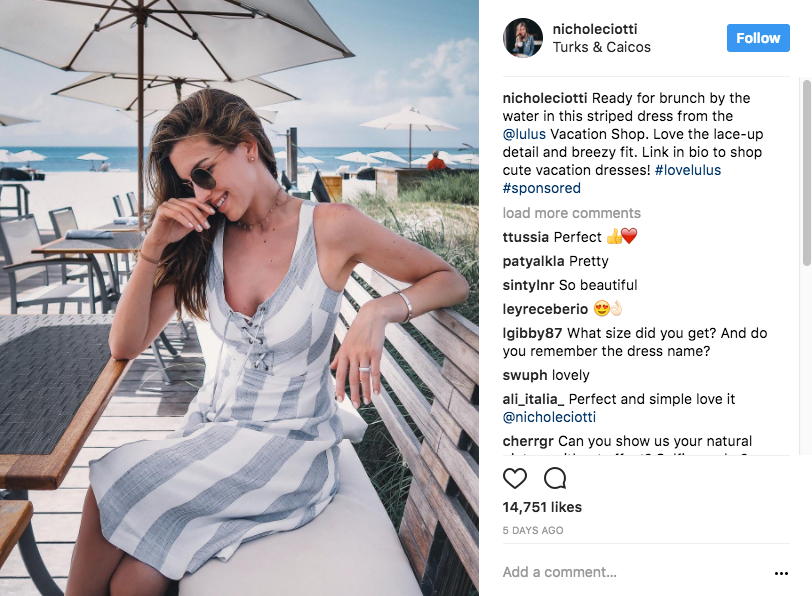
As you can see in the example above, by supplying @nicholeciotti with a dress (and possibly some payment) they put themselves in front of her 450K+ audience that attracted 14K+ likes. All while advertising in a way that’s natural and ultimately led to purchase conversions through her delicate call-to-action.
Lulus has built a business on this type of seemingly easy breezy influencer marketing. Imagine what you can do with your business!
2. Suja Juice
We couldn’t speak about influencer marketing without mentioning local San Diego company, Suja Juice! To say their Midnight Tonic campaign went viral, would be a major understatement.
And if you can believe it… they were able to get their products in the hands and in the feeds of major celebrities, influencers, and raving fans alike at no paid promotional cost.
Let’s dive in and learn how they pulled it off!
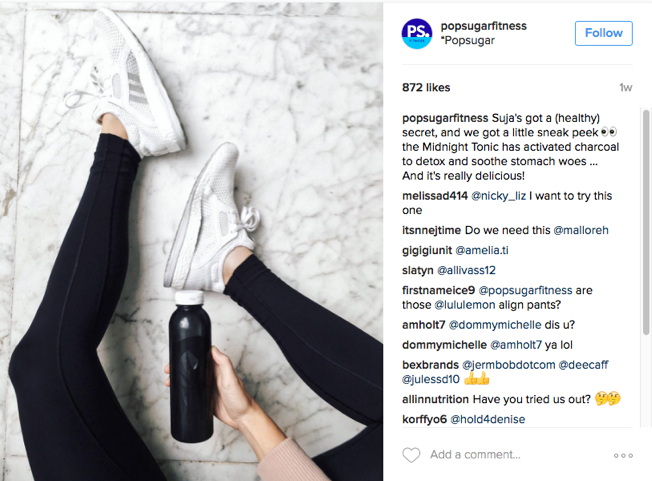
In September 2016, Suja Juice released Midnight Tonic, an all black, limited edition charcoal based beverage to health conscious celebrities with an active social media presence.
A fever pitch ensued, with fans clamoring to get their hands on one of the 1,000 bottles available they witnessed their favorite celeb devouring with enjoyment. The madness caused the site to crash and the product to sell out in three days.
A few of the celebs and outlets that organically posted on a variety of platforms about their experience were Eva Longoria, Jesse McCartney, Kristin Cavallari, and PopSugar.
The campaign generated an awe-inducing 16 million social impressions. Not to mention, countless new customers along the way. All achieved without paying anyone for the endorsement.
What gives this campaign more heart, and meaning beyond tallying up the numbers is how CMO Heather MacNeil Cox described their thought process.
“We chose influencers that have been organic fans of the brand since the beginning, people that love and drink Suja on their own. The Midnight Tonic surprise shipment was a way to thank them for their support, and also re-engage in a conversation about something new and cool.”
Ultimately, the immense success of this campaign stemmed more from the thought process of showing gratitude, rather than focusing solely on how many celebrities they could get to show off their product.
The organic nature of the celebrities’ show and tell of the limited edition Midnight Tonic and their need to be early adopters is what drove the tonic’s virality; the authentic display of a health beverage so tangibly intangible that everyone had to have just a taste.
Suja Juice, we salute you.
Perks of Successful Influencer Marketing & How it Impacts SEO
On a simplistic level the goal of SEO is to achieve links directed to your site from high ranking and authoritative sites in order to drive your rankings for specified keywords to Google’s lauded first page.
You may be thinking if you just get a few solid links from influencers then you’re golden, right? Not so fast turbo.
Link building is much more complex, and so let’s break it down in regards to how partnering with influencers in a strategic way is indeed a boon for your overall SEO goals.
Campaigns need three types of links to grow overall domain authority, as we’re assuming you’re striving to rank specific keywords and phrases on your site.
- Broad, High Domain Authority: This link will point to any section of your website, whether that’s the home page, an internal page, blog, etc. An example, would be Huffington Post, a highly authoritative web news source with a wide reach.
- Specific High-Value Keyword Targeted Pages (with specific anchor text): By doing this individual URLs’ rankings will receive a needed boost. The easiest way is to provide a keyword and associated link for the influencer to place into the copy of their blog post about your product or service. Thus making its inclusion seamless and natural.
- Topical Influence: In other words, links to your domain from other sites within the same niche that give your site more authority and influence in your sector. This linking strategy is particularly pertinent to influencer marketing partnerships. If you’re a technology startup with a revolutionary product, you want to get into the hands of bloggers and journalists who write about the latest and greatest in tech.
While the above may feel a tad overwhelming, if you get it right, you’re ensuring yourself a goldmine of opportunities to drive web traffic and revenue. Not only that, you’re giving your business the opportunity to build relationships with influencers who will become forever fans whether paid or not.
The time really is now to get in on the influencer marketing game. To learn more about how influencer marketing can support the growth of your business, check us out at https://abovethefoldagency.com.
How to Write Good Instagram Bios to Make an Impression in 2017

Writing good Instagram bios might seem straightforward, but it actually requires a lot of thought. According to researchers, it takes less than two-tenths of a second for an online visitor to form an impression of your account. It’s really important for that first impression to be a good one!
In the following guide, we’ll walk you through how to write a good Instagram bio that makes a great first impression, explains what your business does, and convinces new visitors to click the “follow” button!
Good Instagram Bios Tip #1: Your Name
According to Jenn Herman from @jenns_trends, the first step to creating a good Instagram bio is making sure that your name is, in fact, your name! (By this, we mean the “name” field in your profile, not your Instagram username). People searching for you on Instagram will likely use your name or your company’s name, and consistency lets people know that the Instagram profile they’re viewing actually belongs to you and not an impostor.
This might seem pretty obvious, but there’s actually a bigger reason for it. As Jen points out, “your name and username are the only fields that Instagram considers in search queries.” As such, it’s important to make sure that the name you use in your Instagram bio is the one your followers and customers are searching for.
But that doesn’t mean you can’t spruce things up a bit! Do you have a specialty or industry niche? Do you offer a specific service? Are you known for something in particular? You can include this detail in your name as well!

Check out how Jenn Herman includes her profession in her Instagram bio name. Not only can adding a unique skill to your name help you stand out from the crowd, but it can help users search for you by your profession.
Good Instagram Bios Tip #2: Your Skills
A good Instagram bio accurately explains what your business is, and what you do. So if you want to stand out for a particular skill, profession, hobby, or interest, you should include these details in your Instagram bio as well!
Think about what sets you apart from your competitors. Do you have a unique set of skills or experiences that might be of interest to your followers? Not only will including these in your Instagram bio serve as an introduction to new viewers, but it can also determine whether they’ll follow.

Social media influencer and blogger Meg Biram is a great example of someone who includes her interests and hobbies in her bio to show off her personal side as well as her professional side.
Good Instagram Bios Tip #3: Keywords
Using keywords won’t improve your search-ability on Instagram (except, as we mentioned above, your “name” in your Instagram bio) but it will give your account more focus and help you connect with followers who want to engage with your content!
When deciding what keywords to include in your Instagram bio, try to think about both your own core values and the core values of your target audience. If you use Instagram for business, spend some time creating a “profile” of your ideal follower. What are their pain points or interests? And what keywords will help you resonate with them most?
Using keywords that target your audience and niche will help users better understand who you are, what you have to offer, and whether or not your account is relevant to them!

Check out how pop-culture writer Luvvie Ajayi uses tailored keywords in her Instagram bio to personify her brand and connect with her followers.
Good Instagram Bios Tip #4: Website Link
Unlike other social networks, Instagram is strict on where clickable links can be placed. Currently, Instagram only gives users one clickable link in the app, and it’s the link in your bio.
A lot of businesses use the link to send followers to their homepage or blog, which is great! But for ecommerce businesses that want to send followers to specific product pages, campaigns, or webinars, the lack of hot links is a huge challenge.

To get around this restriction, some businesses will frequently update their website link to send followers to their latest products or promotions — and then refer to that link in their Instagram captions. The problem is that Instagram’s photo feed is no longer chronological, so when a business’ post says “link in bio,” that link might not correspond to the actual link in their bio.
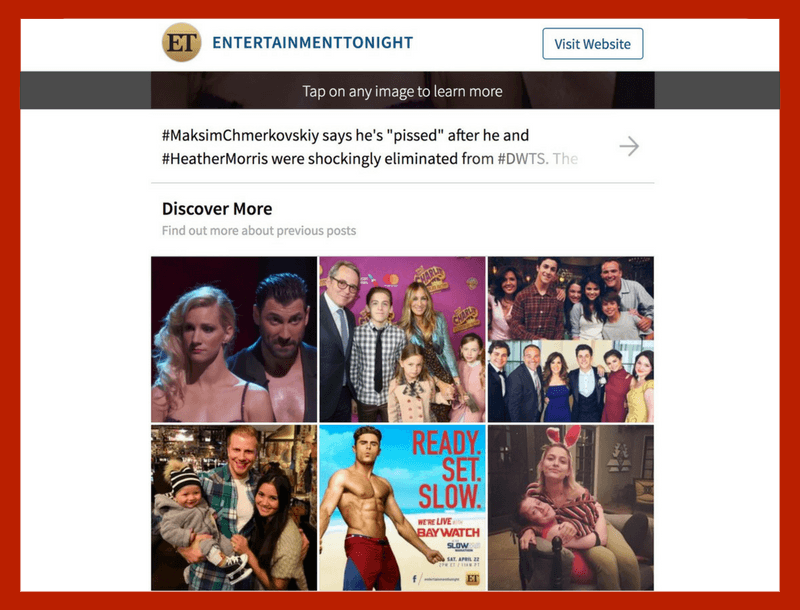
Good Instagram Bios Tip #5: Get Creative
While it’s very important to convey who you are and what you do in your Instagram bio, you should also think of it as a space for you to show off your fun side. At the end of the day, Instagram is a fairly lighthearted medium, so try not to get too stuck on drafting a formal biography!
Here are some great ways to insert creativity into your Instagram bio:
- Use emojis to space out your text
- Include your branded hashtag to promote an Instagram contest or campaign (hashtags in your bio are clickable on the web but not through the mobile app)
- Change the font in your Instagram bio with Textizer
- Add line breaks to your Instagram bio by typing “Return” in your bio on the web version of Instagram (you can’t add line breaks to your bio in the Instagram mobile app)
Check out how designer and creative Dana Fox uses different fonts and emojis to show off her personality in her Instagram bio. Her use of line breaks also makes for a nicer layout within the mobile app!
Instagram Bio Checklist
A good Instagram bio is one that creates a great first impression and convinces users to click the “follow” button on your account! Here’s a recap of what we covered:
- Explain who you are and what you do
- Target your niche audience with specific keywords
- Link to your website or blog, or use Linkin.bio to send followers to your shoppable Instagram feed
- Share your personality
- Provide a way for your followers to get in touch

These are just a few creative examples of how brands are using good Instagram bios to drive engagement and sales. Whether you decide to follow one of the styles above or do something completely different, just remember to keep the tips mentioned above in mind during the creation process!
Benjamin Chacon
Benjamin is a Content Writer at Later and recent transplant from Toronto. You can follow his day-to-day exploits on Instagram @benjaminchacs.

